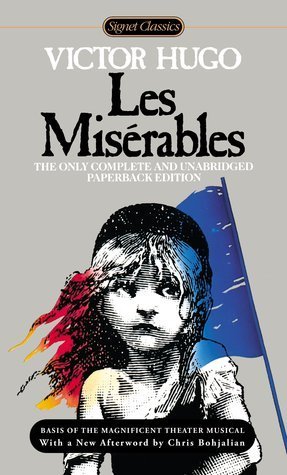Laura Roberts's Blog, page 22
March 26, 2018
Les Mis Readalong: Waterloo, trivia, and books banned by the Catholic church
It’s been another month of “slow reading” Victor Hugo’s classic tome, Les Misérables, and I’m happy to report that Volume 1 is toast!
On the other hand, about half of the past month has been devoted to the Battle of Waterloo – an event that supposedly has a huge impact on the book’s later chapters, but right now seems like quite a confusing change of venue and eras.
Truthfully, I am made of questions concerning this shift. Why are we studying this ancient battlefield? Why is Hugo so obsessed with Napoleon’s defeat? What is the meaning of it all? Why should I care about all of these generals and captains and commanders and blow-by-blow descriptions of how it all went down? Can’t we just skip to whatever the point is, and get back to Cosette – who’s just lost her mother (still unbeknownst to her) – and Jean Valjean, who’s being pursued by Javert?!
Brief excerpts
I thought I would hate all of these seemingly random chapters about Waterloo a lot more than I actually did, so that’s a plus. Some of the descriptions are quite poetic (one of the chapters is entitled “The Fog of War,” so now I know where all these historians have been borrowing the phrase), and since I know absolutely nothing about this particular historical moment, it’s all new information to me.
Here are some of the phrases I jotted down in my notebook:
“Tyranny follows the tyrant. It is grievous for a man to leave behind him a shadow in his own shape.” (V2, B1, C4)
“To depict a battle we need a painter with chaos in his brush.” (V2, B1, C5)
“A creature of light and dark, Napoleon believed himself to be protected in good and tolerated in evil.” (V2, B1, C8)
“Napoleon had been impeached in Heaven and his fall decreed; he was troublesome to God.” (V2, B1, C9)
“It was no longer a conflict of men but of shadows, furies, spirits exalted in a tempest of high courage amid the flashing of swords.” (V2, B1, C10)
“Napoleon’s tragic miscalculation is known to everyone: he looked for Grouchy but it was Blücher who came – death instead of life.” (V2, B1, C11)
“Waterloo was the hinge of the 19th century. A great man had to disappear in order that a great century might be born.” (V2, B1, C13)
“At nightfall, in a field near Genappe, two officers, Bernard and Bertrand, came up with a haggard-eyed man who, having been borne thus far by the tide of defeat, had dismounted and, holding his horse by the bridle, was walking back alone in the direction of Waterloo. It was Napoleon, still trying to go forward, the giant somnambulist of a shattered dream.” (V2, B1, C13)
We still have until the end of March before the full book devoted to Waterloo is finished, so hopefully the connection to Hugo’s previously established characters and their story arcs will eventually be revealed!
Color commentary
I have left off reading Bellos this month, so far, as I wanted to get through all the chapters before reading his commentary, but I will be sure to dive right into that once Waterloo is finally over on March 30th.
Useless trivia
According to an article at Useless Daily, “More than a quarter of the novel – by one count 955 of 2,783 pages – is devoted to essays that argue a moral point or display Hugo’s encyclopedic knowledge, but do not advance the plot, nor even a subplot.” So I’m NOT crazy for thinking that Hugo is a novelist that goes off on lots of tangents! I distinctly remember these diversions derailing my reading, back in high school, as I had no idea what he was up to or rambling on about in these sections.
Another interesting factoid: apparently the Catholic church banned this book! There’s a list of authors who have been banned by the church on Wikipedia, and apparently Les Misérables was on the list until 1959, which places him in the company of such dangerous authors as Copernicus, Dante, Johannes Kepler, the Marquis de Sade and Madame de Staël, all of whom had books banned and whose bans were later reversed.
Join us!
If you’re not reading along with the group yet, you can still jump in! We’re just starting Volume 2 (Cosette), and as of today the group should be finishing up Book 1, Chapter 15. Join us with your comments on Twitter using the hashtag #LesMisReadalong, and enjoy the novel of the century one chapter at a time.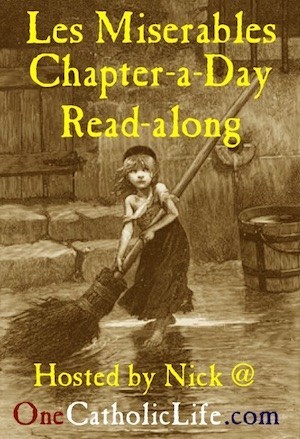
The post Les Mis Readalong: Waterloo, trivia, and books banned by the Catholic church appeared first on Buttontapper Press.
March 19, 2018
It’s time for the Blogging from A to Z April Challenge 2018 theme reveal!
It’s that time of the year again: the annual Blogging from A to Z April Challenge theme reveal.
This year I’m in the middle of writing a book about online dating, entitled No More F*ing Weirdos: Online Dating for People Who Are Sick of Drama, Delusions and Douchebags. It’s currently available for pre-sale at Amazon, if you’re in need of a laugh or some friendly advice.
Here’s the cover:
It’s a mix of advice and anecdotes from my time as a single woman looking for love online, along with actionable steps you can take to improve your profile and your dates. So I figured: what better way to pump my readers up for my new release than to share some of the content from my forthcoming book here on the blog?
Therefore, this year’s theme will be Online Dating from A to Z!
I’ll be covering everything from Apps to Zen this month, with forays into the good, the bad, and the downright fugly sides of meeting people online.
If you’ve never tried online dating, I highly recommend it, both for the hilarious hijinx that often occur as a result of attempting to make conversation with people via computer/tablet/phone and because of the warm-and-fuzzy romantic potential to find the man or woman of your dreams. As I like to tell everyone who will listen, I met my husband online – back before any of these crazy swipe apps even existed – and we’ve been inseparable ever since. Sure, I had to suffer through a series of bad dates (including some of the worst dates I’ve ever been on in my life), but I can definitely say that without a doubt, it was all worth it to find him in the end.
So, whether you’re a seasoned online dater or a total newbie to the process, join me during the month of April for tips, tricks, funny stories from the online dating trenches (and a few sewers), and lots of encouragement.
Have you ever tried online dating?
What were the results? Share your most memorable online dating story with me in the comments (and don’t forget to sign up for my mailing list) for a chance to win a free copy of my new book!
The post It’s time for the Blogging from A to Z April Challenge 2018 theme reveal! appeared first on Buttontapper Press.
March 12, 2018
Putting theories into practice: Notes on The Happiness Project
The Happiness Project is the second of Gretchen Rubin’s books that I read, but it’s actually the first in her self-knowledge series that includes Better Than Before, Happier At Home, and The Four Tendencies.
This book has grown beyond one woman’s quest to find happiness, and has inspired a whole movement of folks searching for happiness and creating their own happiness projects. So today I wanted to share a few of my comments about this book, which I highly recommend to anyone who hasn’t read it yet!
In her Note to the Reader at the start of the book, Rubin observes:
“During my study of happiness, I noticed something that surprised me: I often learn more from one person’s highly idiosyncratic experience than I do from sources that detail universal principles or cite up-to-date studies. I find greater value in what specific individuals tell me worked for them than in any other kind of argument – and that’s true even when we seem to have nothing in common. In my case, for example, I would never have supposed that a witty lexicographer with Tourette’s syndrome, a twentysomething tubercular saint, a hypocritical Russian novelist, and one of the Founding Fathers would be my most helpful guides – but so it happened.”
She turns to various scientific studies for guidance on choosing projects for her own happiness, but she also puts to the test items she has read in novels and various kinds of philosophical and religious ideas about happiness, in order to see whether they will work for modern-day people like her.
Perhaps one of the things I enjoyed most about Rubin’s book was her willingness to explore both her positive and negative traits, in order to seek out the kinds of things that would make her, personally happy. Many self-help books seem to try to fit everyone into a specific box of Happiness that is meant to apply equally to everyone, but Rubin’s book is quite different. She designs her own Happiness Project around things that she already knows bring her joy, as well as pushing her own limits by trying new things that are touted as happiness-inducing. Ultimately, her goal is to “Be Gretchen,” which means to embrace her own likes and dislikes, but also work to make herself the best she can be, by knowing her strengths and weaknesses and always seeking to improve – but without bending to whatever happiness fads and trends are currently taking the world by storm.
Much like the Marie Kondo “Does it bring joy?” question for cleaning house, Rubin asks whether different activities or practices bring her joy. If they don’t – even after modifications to suit her personality – out they go. I like this approach, because it leaves room for trying new things, but also acknowledges that we may not actually like EVERY new thing we try, and that’s totally okay.
I also really enjoyed the way Rubin decided to structure her project as a year-long exploration, with monthly themes. She assigns each month a different quest (Vitality, Marriage, Work, Parenthood, Leisure, Friendship, Money, Eternity, Books, Mindfulness, Attitude, and “Boot Camp Perfect”), and challenges herself to focus on different elements of happiness throughout the year. This kind of monthly theme for life and work is something I’ve started to emulate this year with my Buttontapper Challenge (which is focused on Positivity during the month of March). Viewing life as a series of challenges is an interesting way of looking at the world, and when I get to set my own challenges, it feels quite exciting and empowering.
In the month of December, Rubin attempts to draw all of her findings and self-improvements together for “Boot Camp Perfect“: the application of all lessons learned to her real life, as best she can. As you can imagine, this is quite a feat! While she doesn’t always succeed at attaining perfection, it’s inspiring to hear about how she is able to learn from her failures and still bring a positive perspective to situations that would otherwise plunge her deeper into unhappiness.
Ultimately, it’s the cumulative effect of tracking her happiness over a year that helps her achieve greater happiness each day. Which is also what people who Bullet Journal are trying to do, so naturally there is a Happiness Project Journal to go along with the book!
So, if you’ve ever thought about your own happiness – or that of those around you – this is a great book to pick up. Give it a whirl, if you’re looking for some new ways to change your life!
The post Putting theories into practice: Notes on The Happiness Project appeared first on Buttontapper Press.
March 1, 2018
The Pessimist’s Positivity Challenge: Why be positive?
As we kick off the March edition of the Buttontapper Challenge, it’s time for a big question: Why be positive?
Maybe it seems blindingly obvious that positivity is a good thing. It is, after all, the word’s very definition! But did you also know that engaging in positive thinking is a choice?
It’s true: we all make choices about our mindset, daily, from the moment we grouchily hit our snooze buttons each morning to the moment we fall into bed, exhausted, at the end of the day. Although many of our circumstances may be out of our control, our attitude is not. We can choose to accept a situation or even embrace it, or we can rage against our fate, and even fall into a state of learned helplessness. Which one seems a better use of your energy?
That all depends on you.
While we can all choose positive thinking, why do some of us more naturally gravitate towards it, while others tend to be more pessimistic? I’ll admit I’m much more of a pessimist (or “realist,” as some would argue) than an optimist. As the old saying goes, I prefer to expect the best, but plan for the worst. In taking several Positive Psychology classes online, I discovered that negative emotions actually have a “high survival value,” meaning that they give us specific actions to take in response to these feelings, such as the infamous “fight or flight” reactions. Positive emotions, on the other hand, tend not to lead to any direct action – although they can certainly be used to create enduring skills and resources, as well as temporarily feeling good about ourselves.
So what can we do to consciously choose positivity in our daily lives?
In the course I’m currently taking, the focus is on “Applications and Interventions,” or exercises that people can take in their daily lives in order to focus more on positive emotions and attitudes. The teacher of this course, James Pawelski, suggests four ways that we can all work to cultivate positive emotions:
Remember a time when you felt positive emotions
Act like you are feeling those emotions
Seek out situations where you will feel those emotions
Be more mindful of your feelings
Have you ever tried cultivating positive emotions in your life? Did you use any of these methods, or was there something else that worked for you? What is your goal in seeking out positive emotions or focusing on positivity?
Take the 30-Day Social Media Positivity Pledge!
Start cultivating personal positivity today: sign up for my 30-Day Social Media Positivity Pledge, to show you’re committed to making a change. Enter your blog’s URL on the Linky list below, then hop over to other participants’ blogs during the month of March for more ideas on how to spread and embrace positive thinking. It’s fun, and free!
You can also grab the badge for your blog or social media profiles, to show your participation:
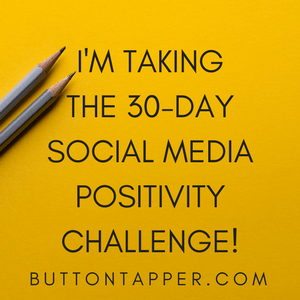
Don’t forget to link back to this post!
The post The Pessimist’s Positivity Challenge: Why be positive? appeared first on Buttontapper Press.
February 26, 2018
One month of “slow reading”: A Les Mis Readalong check-in
Having announced my participation in the Les Misérables Chapter-A-Day Readalong on February 4th, I thought I’d just check in with a quick update on my progress thus far!
Catching up with the group took me a couple of days worth of reading, but since all of the chapters are quite short, this went fairly quickly. I managed to meet up with them on Twitter on February 6th, where they were sharing quotes and comments on Fantine (aka Volume 1), Book 4, Chapter 1, with several comments, including:
Hooray! I am finally all caught up on the #LesMisReadalong as of this morning. Happy to see Fantine FINALLY arrive on the scene in Book 3, Chapter 2… too bad Tholomyes is such an obvious scoundrel; “wrinkled and toothless” should’ve given her a clue to avoid him! pic.twitter.com/sFneiCgwCx
— Laura Roberts (@buttontapper) February 6, 2018
and
Fantine Book 3, Chapter 4: “That day was composed of dawn, from one end to the other. All nature seemed to be having a holiday, and to be laughing.” HOW TRAGICALLY IRONIC! #LesMisReadalong pic.twitter.com/tyDAK0fj1b
— Laura Roberts (@buttontapper) February 6, 2018
and
An unusual comparison between Parisians and cats, in Fantine Book 3, Chapter 5: “… the cat so despised by Count Angles possessed the esteem of the republics of old. In their eyes, it was liberty incarnate…” pic.twitter.com/ceeTlto67R
— Laura Roberts (@buttontapper) February 6, 2018
If you’re not already following me on Twitter, what are you waiting for? I am obviously on point with my GIFs, here!
Tracking my progress
Instead of simply checking off the chapters as I go, I decided to repurpose my daily Moleskine planner as a readalong tracker, and I’ve been writing down quotes from each chapter as a record of my daily progress.
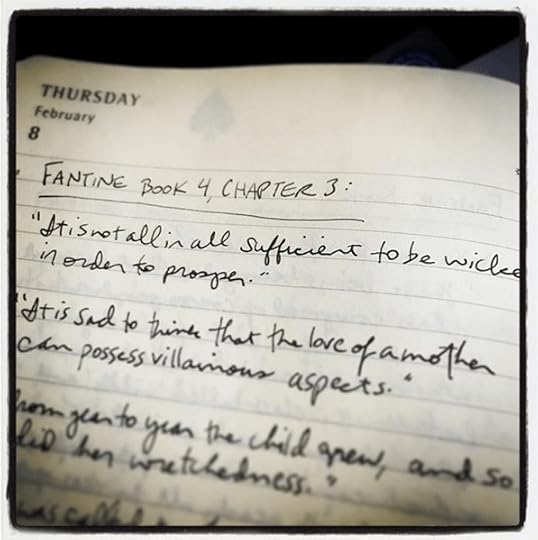
Color commentary
I’ve also been reading The Novel of the Century by David Bellos, which is a bit spoileriffic in parts (it does assume you’ve already read through Les Mis, or at least watched a stage or screen version once), so I’ve been writing down quotes that I can share with the group on Twitter without ruining it for anyone. Here are some of the bits from that volume that have struck me so far:
“[Les Misérables] is a work of reconciliation – between the classes, but also between the conflicting currents that turn our own lives into storms. It is not a reassuring tale of the triumph of good over evil, but a demonstration of how hard it is to be good.”
Quoting from the Encyclopédie of Diderot and d’Alembert:
“Poverty is the mother of great crimes; sovereigns are responsible for making people misérable and it is they who will be judged in this world and the next for the crimes that poverty commits.”
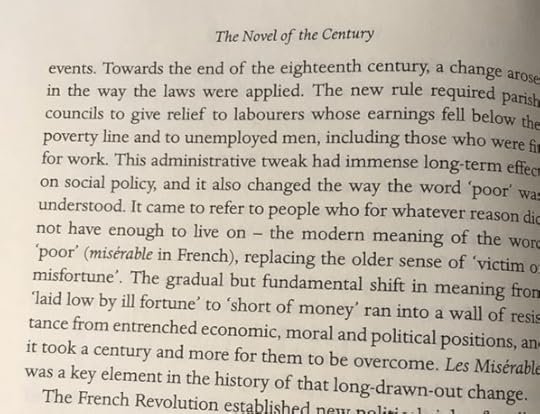
Commenting on the way that Les Mis deftly avoids sex at every turn:
“Les Misérables is unusual among 19th-century French novels for not talking at any point about adultery or even sex. Its main characters are celibate… That, surely, is the main impact of the Biard Affair on Hugo’s intention as the first draft of Les Misérables: to write about everything except that.” (p. 32)
And commenting on the continuous misery Hugo inflicts upon Fantine (whose character was, in fact, inspired by a real-life scuffle between a property-owner and a prostitute that Hugo witnessed):
“Not many of us have to face brutality, or learn how brutal we could be.” (p. 48)
Join us!
If you’re not reading along with the group yet, you can still jump in! We’re still in Volume 1 (Fantine), and as of today the group should be finishing up Book 7, Chapter 3. Join us with your comments on Twitter using the hashtag #LesMisReadalong, and enjoy the novel of the century one chapter at a time.
The post One month of “slow reading”: A Les Mis Readalong check-in appeared first on Buttontapper Press.
February 23, 2018
The Pessimist’s Positivity Challenge
March is almost here (where did all the time go?!) and it’s time to introduce my theme for the next installment of the Buttontapper Challenge. If you’re new to the challenge, this is something you can participate in daily or whenever the mood strikes you. There’s no wrong way to participate!
So, what’s the deal?
About the Challenge
The Buttontapper Challenge is a writing challenge with a new theme each month. We’ll follow a set of prompts and write about them each day, sharing snippets on social media using the hashtag #ButtontapperChallenge.
March Theme: The Pessimist’s Positivity Challenge
Positivity is all the rage these days, and while I am certainly interested in cultivating a positive mindset, I’m also a pessimist at heart. I prefer to expect the best but prepare for the worst, because I’ve been disappointed a lot in life. Ultimately, it’s a coping mechanism.
But there’s plenty of evidence that positivity is good for your health – both mentally and physically – and that positive people live longer. Thus the positivity challenge!
While I don’t like empty phrases that signify nothing, nor the idea of following popular “gurus,” I’ve been taking some Coursera classes on the subject of Positive Psychology online, which has given me a lot of food for thought. So, that’s why I’ve decided to dedicate my posts for the month of March to positivity, and the idea that even a cranky pessimist can embrace positive thinking.
I’ve divided the list up into prompts that will help you think about positivity from different perspectives, including exercises and tips for positive thinking that I’ve learned along the way. I can’t wait to see your responses to these prompts!
The challenge prompts are completely open to interpretation, but I’ve written up a little explanation for why I chose each one, and what I’ll be writing about that day, to give you some ideas about what to write in case you find yourself stuck.
March Prompts
Why Be Positive? – Maybe it seems blindingly obvious that positivity is a good thing, but did you also know that engaging in positive thinking is a choice? We can all choose positive thinking, so why do some of us more naturally gravitate towards it, while others tend to be more pessimistic, and what can we do to consciously choose positivity in our daily lives?
Gratitude – Gratitude journaling is a popular method for coping with tough times. It’s also a strategy that actually works! Do you currently use gratitude journaling in your life, or have you ever used this method to deal with a difficult situation?
Journaling – In addition to gratitude journaling, journaling in general is a great daily habit to develop. Some people track their moods, others capture their thoughts, some do morning pages, and still others do just one line per day. There are lots of different journaling styles. Do you keep any sort of journal or log, and how do you find it helpful?
Brainstorming – Brainstorming is another technique writers often use for getting out of a rut or sorting through issues. It’s incredibly easy to do, and a lot of it involves simply keeping your pen moving over the paper until your time is up. What kinds of things do you use brainstorming for, and how might it help you with different issues in your life?
Fuel – We all know we need fuel for our bodies, in terms of food, but have you ever considered the possibility that you really are what you eat? What does that mean, in terms of both your mental and physical health? Are you a Cheeto or a stalk of celery? And what kinds of fuel work best for your body?
Miracle Morning – I read The Miracle Morning at the start of this year, and have been trying to put it into practice ever since. I’m not sure it’s the best daily routine for me, personally, but I’ll share some of my ideas about daily routines, as well as my own routine for starting each day off right.
Productivity – How do positivity and productivity work with one another, and is the ultimate goal of positivity simply to become more productive?
Proof(Reading) – Today is National Proofreading Day, so on the one hand let’s talk about correcting (and dealing with) mistakes. On the other, let’s talk about proof in terms of positive thinking. Does this stuff actually work, or are we all just kidding ourselves? What’s some proof you’ve experienced in your own life, as a result of practicing positivity?
Radical Candor – What is radical candor, and how can practicing it lead to increasing positivity in your life?
Accountability – Why is accountability necessary, and how does it relate to positivity?
Spring Forward! – Today’s the day we spring forward as Daylight Savings Time begins, but it’s also a day to ponder whether positive thinking has given us more of a spring in our step. How is positive thinking affecting your mood?
The Happiness Project – I really enjoyed this book by Gretchen Rubin, and wanted to share some of my thoughts about it today. Have you read the book? What did you think? What might your own version of a “happiness project” look like?
Superstitions – What kinds of superstitious beliefs are holding you back?
What Went Well? – A positive thinking exercise designed by Dr. Martin Seligman, he suggests taking time at the end of each day to ask yourself “What went well today?” Try to come up with at least three things, to increase your overall happiness.
True Confessions – Today is True Confessions Day, so let’s share a few confessions and ponder how sharing our truth actually makes us happier people.
Constructive Journalism – Journalism traditionally looks at the negative side of the world, calling attention to injustices and inequalities, shining a light on the darkness, but it tends not to offer solutions for these problems, which can make a lot of people decide to shut the news out completely. But what if we were to focus on things that are going right in the world, or opportunities for change? Constructive Journalism seeks to build bridges between people, and to offer them a change to get involved in the news, rather than being passive observers. Let’s share some Constructive Journalism with one another today, and celebrate some of humanity’s successes.
Saints & Sinners – Since it’s St. Patrick’s Day, I thought a compare/contrast between saints and sinners might be a fun topic. What’s a negative habit you’d like to change into a positive one? How can you transform yourself from a “sinner” into a “saint,” in this regard?
Better Than Before – Another great book by Gretchen Rubin, Better Than Before challenges us to examine our personalities to try to build positive habits. What does it mean to be “better than before,” and what kinds of things are you working on, in terms of good or bad habits?
San Diego – Oddly enough, San Diego is a bit of a Mecca in terms of positivity. Lots of people flock here for the warm weather and near-daily sunshine, which can certainly help. Why else is San Diego such a great place to live, if you’re looking to embrace positive thinking? Alternatively, where in the world do you live, and what kinds of resources are there for people who want to embrace positivity in your city?
Equinox – Today is the Spring Equinox, when our daylight hours are just as numerous as our hours of darkness. What kinds of things help you to achieve your own internal equilibrium or equinox, in terms of positivity exercises or actions?
Tracking Wins – Another great exercise for embracing positivity is the concept of tracking your daily “wins.” Suggested by Classy Career Girl founder Anna Runyan, the idea is to create a list of things to do each week, focusing on your Top 3, and then to make a list of items you completed in order to achieve your goals at the end of each day. Similar to the “What went well?” exercise, list 3 things you consider “wins” for the day, to keep yourself focused on moving closer to your bigger goals.
Money – We’ve all got a relationship to money, whether we like to acknowledge it or not, and some of our thoughts on the subject can be decidedly negative. Today I’ll share an exercise that will improve your relationship with money, courtesy of Lisa Jacobs.
Relationships – How can you bring positive thinking and positive psychology techniques into your relationships?
Creativity – What kind of relationship is there between positivity and creativity?
Mood – Tracking your moods can reveal a lot about your life. Do you use mood trackers, and if so, how often do you find yourself feeling positive vs. negative in a weekly or monthly period?
“Slow” Reading – I’ve been participating in the Les Misérables Readalong since the start of this month, and one of my fellow participants has described this as a “slow reading” challenge. What does it mean to read slowly, and how can this be beneficial in our fast-paced world?
Habits – Habit tracking is huge! How do you track your habits (or do you?), and have you seen any changes in your life as a result?
Artist Dates – Part of The Artist’s Way emphasizes taking yourself on “artist days,” and I think this is a great positivity practice, as well. What kinds of dates do you like to go on by yourself, and how do they help boost your mood?
Positivity Classes – I’ve been learning a lot from UPenn’s Coursera classes on Positive Psychology. What other kinds of classes exist, to help improve positive thinking and focus?
Grit – One of the key ingredients in positive psychology is “grit.” What exactly is grit, and can we learn how to be “gritty,” resilient people even in times of crisis?
Lessons Learned – What did you learn this month from practicing a positive outlook, and how will you continue with any of these exercises in the future?
Grab the Free Printable
Click the button to download a free printable copy of these prompts for personal use:
Download Here!
So, are you ready for a challenge?
Join me on March 1st @ButtontapperOfficial on Instagram, @Buttontapper on Twitter, or in my Buttontapper Challenge Facebook Group for the first day of the March challenge – and spread the word!
The post The Pessimist’s Positivity Challenge appeared first on Buttontapper Press.
February 19, 2018
Patriotism in an age of rage
Although at first Patriotism may not seem like a topic that fits into my True Love theme for this month, I feel it’s fitting to examine the concept today. In the USA, we’re supposed to be celebrating Presidents’ Day, but I must admit that this holiday has always been perplexing to me. Why should we celebrate the President of the U.S. on a random day in February? Are we supposed to be celebrating the current, sitting President, or just the concept of the presidency itself? What, exactly, is this day meant to celebrate, and how does one properly celebrate it?
First of all, I certainly don’t think there is anything to celebrate concerning our sitting President. He is, frankly, a disgrace. He does not represent me, my values, or my beliefs about America, and he is altogether a disgusting human being, inside and out. There is nothing remotely likeable about him and, if anything, he inspires feelings of contempt rather than national pride.
So, clearly, the notion of celebrating this particular President does not appeal to me. But even the concept of celebrating the office of the President more generally – despite some of its outstanding examples of leadership and excellence – is not something that makes me want to run right out and buy a dozen American flags to wave around while chanting “USA! USA!”
The notion of patriotism is a challenging one, at the best of times. As Mark Twain put it, “Patriotism is supporting your country all the time, and your government when it deserves it.” The last part of his statement makes perfect sense to me; we won’t always agree with the things our government does in the name of “the people,” and thus we may sometimes need to protest it. That’s one of the most American things we can do, in my view. But the former part of the sentence is still confusing. What does it mean to “support your country”?
Some people seem to think that supporting our military is the same thing as supporting our country. And, I’ll admit, that makes some sense. Members of the military are often viewed as serving their country, making personal sacrifices for the greater good, protecting our country and our people from hostile outside forces.
On the other hand, isn’t the United States’ military actually responsible for a great deal of hostility towards other countries – particularly when our leaders believe we, as a nation, have the right to some sort of natural resources that country possesses? Or when our leaders (often mistakenly) believe that they know better than the people who actually live in those countries, and attempt to impose American culture and values upon them, using our military might?
Like I said, this is a difficult topic to pin down. There is no truly black and white (or red, white, and blue) answer here. The U.S. has a history of violence, in its creation as well as its continued existence, and it has at various times directed its hostility both towards foreign countries and its own people. That being said, I believe this is true of any country in the world; the U.S. is not special in this regard, though it is one of the only nations that devotes so much money to military spending, and to arming its own people. Those are both, frustratingly, very American ideals.
And that ties into my second quote concerning patriotism. As former French President Charles de Gaulle put it, “Patriotism is when love of your own people comes first; nationalism, when hate for people other than your own comes first.”
In 2018, is America currently celebrating patriotism, the love of one’s country, or nationalism, the hatred of other countries?
This is an important distinction. With love, all things are possible. But with hate in our hearts, can our mission ever truly be successful? Even if we really, honestly believe in spreading democracy and freedom to the rest of the world, if our secret underlying belief is that Americans are better than everyone else, that is a work of nationalism, not patriotism. And that is not a mission that I can support.
To close, I’d like to share a quote from a current American Senator, Cory Booker, which I think best encapsulates what America’s mission should be, with regard to true patriotism:
“Patriotism is love of country. But you can’t love your country without loving your countrymen and countrywomen. We don’t always have to agree, but we must empower each other, we must find the common ground, we must build bridges across our differences to pursue the common good.”
What do you think?
Is Patriotism something you can easily embrace? What does Patriotism mean to you?
The post Patriotism in an age of rage appeared first on Buttontapper Press.
February 12, 2018
Valentine’s Day surprises for long-term couples
My husband and I have been married for almost 10 years now, and as with any long-term couple, Valentine’s Day can be a challenge. It’s not that we don’t love each other, but more that the typical expressions of love and romance can seem a little stale. This can be true even with couples who haven’t been together for long, especially since Valentine’s Day tends to rely heavily on romantic clichés. Flowers, chocolate, a cute card, dinner and a movie… isn’t there more to expressing one’s love than the usual trinkets and ho-hum dates?
Never fear! After scouring the internet for some creative ideas, I’ve compiled my five favorite alternatives to the nightly Netflix and chill routine. Try one of these, if your relationship could use a little V-Day boost.
Recreate your first date
It seems like a no-brainer, now that all these articles mention it, but recreating your first date is a great way to reconnect with those thrills and chills you got the first time you met your spouse or long-term lover. My husband and I first met at an Italian café in Montreal, so I could recreate our date by taking him out for coffee in Little Italy and following up with some tasty Chinese food – all the while including some more of the great conversation we had on our original date, along with new and exciting plans for how to spend the rest of our future together.

Photo credit: rawpixel.com via Unsplash
Change your location
For long-term couples, a quick change of location can sometimes make all the difference. Splurge on a fancy hotel room or Airbnb in your own city to give yourself some new perspectives. Get a room with a view, or a private hot tub, or order in room service. A little bit of pampering – especially since Valentine’s Day falls on a Wednesday this year – can be quite a treat.

Photo credit: Joshua Ness via Unsplash
If you’re on a budget, why not clean out the rings around your bathtub and plan a soothing soak for your significant other? You can DIY some fizzy bath bombs, light a few dollar store candles, set the mood with your lover’s favorite music, and get to wooing!

Photo credit: Hisu lee via Unsplash
A great escape
I have to admit, the idea of doing a puzzle together is strangely romantic, so I really like the thought of trying an escape room with my husband. Like taking a class or trying any new activity together, this is an exercise in team-building, as well as an excuse to be trapped in a room together for at least an hour, and it offers a new twist that mystery lovers and puzzlers can appreciate.

Photo credit: Jez Timms via Unsplash
Add some treasure to your chest
I wrote an entire book about sex toys, so the idea of trying something new in the bedroom as a Valentine’s Day surprise is always appealing. If you’ve never given Ye Olde Marital Aids a whirl, I highly recommend trying some this year. Some of the most inexpensive starter toys are cock rings with a bullet vibrator, which are meant for couples’ usage, so why not grab one at the pharmacy and give your spouse a buzz?
For the more adventurous, hit up your favorite online store together and pick out some new toys! Rather than ruining the surprise by shopping together, this adds to the anticipation as you eagerly await your items’ arrival.
Check your bucket list
Another great idea for a Valentine’s Day adventure is to check an item off of your bucket list. Whether you and your spouse both share a list, or you each aim to check off a new item, this can make for some fun and exciting alternatives to another romantic dinner date. Maybe one of your items is dinner – but involves eating something incredibly exotic or difficult to find? Make a day of it, and challenge one another to see how many items you can actually check off in a 24-hour period.
Again, even if you’re on a budget, there’s surely something unique or exciting in your own town that can check that box. What about getting up early to see the sunrise from a unique vantage point? Or visiting that museum with the special exhibit you’ve been meaning to explore? Maybe it’s a grand romantic gesture: rose petals on the bedsheets, or a public declaration of love! Think big, think outside the box, and think about the joy of experiencing something new, rather than the cost of doing something over-the-top.

Photo credit: Kaci Baum via Unsplash
Cuddle up!
Finally, here’s one of my favorite Valentine’s Day hangouts that tends to be inexpensive and avoids the crowds: Go for a picnic if you’re somewhere warm, or seek out a fireplace and hot chocolate (or mulled wine) if you’re somewhere cold, and just snuggle. The best part of Valentine’s Day is being in love, and getting to be with your loved one, so embrace each other as much as physically possible and enjoy the day.
Want more love?
For additional ideas and tips for how to rev up your love life this Valentine’s Day, grab a copy of my new True Love bundle, which includes five of my bestselling love and relationship books for just five bucks!
The post Valentine’s Day surprises for long-term couples appeared first on Buttontapper Press.
February 9, 2018
Types of Love and The 5 Love Languages
In an extra special super-duper combo pack of love and romance, today I’m going to be exploring the traditional Greek types of love as well as Gary Chapman’s book The 5 Love Languages. Are you ready? Then let’s jump right in!
Types of Love: Ancient Greek Style
The ancient Greeks believed there were eight different kinds of love:
Eros – erotic love
Philia – affectionate love
Storge – familiar love
Ludus – playful love
Mania – obsessive love
Pragma – enduring love
Philautia – self love
Agape – selfless love
They seem to have either forgotten or skipped over unrequited love! Perhaps it was considered part of Mania? After all, an unrequited love is often obsessive.
In any case, I find these types quite fascinating. While most modern folks would likely agree that “love” encompasses Eros and Agape, and perhaps even Pragma as the goal for marriage, many people seem to find Philia and Storge to be a waste of time. If our love songs are any indication, we’re all searching for blazing fires of passion, not familiar or affectionate companionship. And that seems like quite a mistake. After all, one cannot burn with the bright blaze of passion forever. Eventually the flame will burn lower, or snuff out entirely – particularly if you don’t continue to fuel your fire with something like affection, playfulness, and familiarity.
Which types of love are most important to you, and have you ever thought about each of these different kinds of love in your relationships?
Love Languages for Modern Times
 In keeping with this concept of different types of love, but addressing a more modern audience, Gary Chapman has conceived of five “love languages” that apply to romantic relationships. His five languages are:
In keeping with this concept of different types of love, but addressing a more modern audience, Gary Chapman has conceived of five “love languages” that apply to romantic relationships. His five languages are:
Words of Affirmation
Quality Time
Receiving Gifts
Acts of Service
Physical Touch
His book, The 5 Love Languages, explains how each of these languages works, and he is careful to note that your partner may not speak the same love language as you do – which often accounts for arguments and fights between couples. Oftentimes, he explains, people who think they are expressing love are simply not using the right language to address their spouse or significant other. For instance, they might be offering gifts when the other person prefers physical touch or words of affirmation.
After taking an online assessment, I discovered that my “primary” love language is Quality Time. My husband, however, prefers Words of Affirmation. So although I assumed I was expressing my love for him by spending quality time together, he actually feels rather neglected because I haven’t – literally, in this case – been speaking his love language. Time to remedy the situation with some I love yous!
Which of these types of love languages are you most drawn to, and does your partner use the same love language as you do?
Want more love?
If you haven’t joined the Buttontapper Challenge yet, what are you waiting for? Download your own copy of my daily prompts, and write a short response to today’s concept, Types of Love. Don’t forget to include the hashtag #ButtontapperChallenge if you share your work on social media!
The post Types of Love and The 5 Love Languages appeared first on Buttontapper Press.
February 4, 2018
A “Miserable” Reading Challenge: Les Misérables Chapter-A-Day Read-Along
Another reading challenge? Do I really need another one?
If it’s the Les Misérables Chapter-A-Day Read-Along, then my answer is HELL YES!
As you may have noticed, with my recent review of How to Be Parisian Wherever You Are, I am a bit of a francophile. Anything French is automatically cool and intriguing to me, and although I’m not entirely sure where this obsession originally comes from, it certainly goes back to my youth. My mom took the family to see the musical performance of Les Misérables when it came to Chicago, and of course we eventually ended up singing all the songs from the show afterwards, buying a copy of the sheet music to play on the piano, and so forth.
I was the only one crazy enough to grab a copy of the unabridged Victor Hugo novel that inspired the musical, and attempt to read it all the way through.
All 1,488 pages of it.
I’m not sure I ever actually finished reading this volume, because although I toted it with me absolutely everywhere when I was in high school, I was also very frequently (and, quite rudely) interrupted in my reading by folks who had the gall to ask “Whatcha reading that for? Why don’t you just go see the musical?”
*insert groan of frustration and evil eye aimed at the latest foolish inquirer*
There was, in fact, one particularly annoying boy that I got stuck sitting next to in study hall, who would borrow the comics section of the newspaper from the teacher each day and laugh uproariously at each and every strip, pointing out the most hilarious ones to me and awaiting a similar reaction. When I did not comply, he would nudge me with an elbow and ask why I wasn’t falling all over myself laughing, and then insinuate that I wasn’t smart enough to get the joke – despite the fact that I was clearly reading a larger tome than he would ever complete in his lifetime.
The teacher would always tell him to stop bothering me, but he would always pick up right where he left off the next day. I became quite skilled at ignoring him, while attempting to read another chapter in my book and surreptitiously checking my watch to see when this oh-so-Sartre-esque Hell Of Other People would finally end. (Come to think of it, this is definitely where my hatred of being asked “What are you reading?” by random men comes from. DO NOT BOTHER WOMEN WHEN THEY ARE READING.)
In short: when I first learned about this reading challenge from Lory at The Emerald City Book Review, I knew this was finally my chance to read the book, cover to cover, without any interruptions. At last, I will finally get my revenge on that idiotic boy and his persistent gaslighting and derailing! I will finally get through all of Hugo’s philosophical rambling! I will finally redeem myself as a reader by finishing an enormous tome that is NOT required reading!
In short, this is what the French call le destin.
Now my only dilemma is which translation should I read? I’m leaning towards the one pictured above, as this is the version I attempted to read back in high school. There are quite a number of translations around, and Deacon Nick (who started this challenge) suggests three different options. I am waffling because I usually like to read the same version the teacher or challenge leader is using, but I am a little nostalgic for that fat paperback… plus it’s only 49¢ for the Kindle edition. Okay, SOLD! (I will ponder buying another paperback edition later.)
So, since I am a little over a month behind, it looks like I’ll be spending the rest of my weekend getting caught up on Les Misérables. A sweet – or should I say superb? – way to end an ordinary weekend.

The post A “Miserable” Reading Challenge: Les Misérables Chapter-A-Day Read-Along appeared first on Buttontapper Press.




